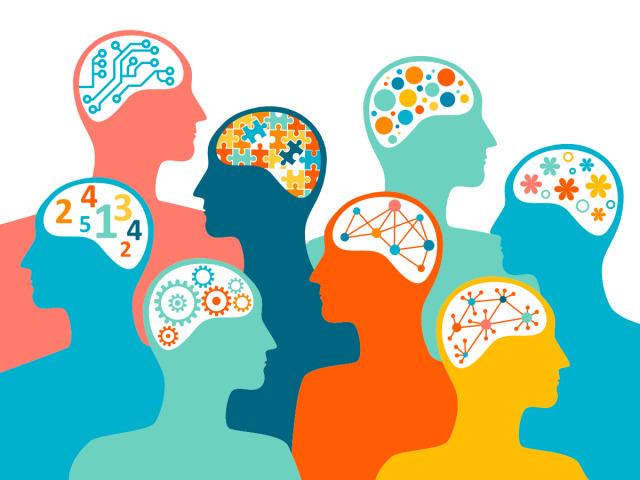An approach to problem-solving, assessing information and learning, often used by people with dyslexia, that involves pattern recognition, spatial reasoning, lateral thinking and interpersonal communication.
Dyslexia is not a ‘disorder’ but an evolutionary advantage that can be harnessed in times of entropic change. The dyslexic gene appears to be the personification of the lateral-thinking or adaptive human gene, enabling people to see problems in visual form. Dyslexics embody an ability to perceive patterns where others see nothing. The best estimate is that 20% of the UK population is dyslexic. However, dyslexics with a low IQ are unable to interpret the information fed to them by a linear educational system, as before that information can be useful, they have to build an internal mental hologram that they can then populate with the information of conventional education. As that hologram is increasingly populated, they see linkages between information points that linear thinkers could not see and, as a result, see patterns. A few go on to make new quantum advances in thinking that feedback positively into society.
As a result, most dyslexics will initially present as slow learners with poor reading and writing skills. As they build what we call their ‘learn to learn’ programme, they start to catch up with linear thinkers, usually by the time they are at university, where they can excel as their unique thinking power becomes noticed. Interestingly, one of the hallmarks of this 'learn to learn' programme is that those that have it keep it for the rest of their lives, and would be categorised by others as ‘always questioning’. Linear thinkers seem to stop questioning from their forties onwards. However, conversely for those with dyslexia and a low IQ, life within a modern human society at peace is extremely challenging, as many will have failed in the education system, and they will naturally feel separate from the society in which they live. These factors, combined with a lack of respect for the rules and economic desperation, mean that dyslexics represent 50% of the UK’s prison population.
On the positive side, a society that recognises the potential of lateral thinkers (and especially dyslexics) across the whole IQ spectrum, and is also prepared to invest in and optimise their educational process with early dyslexic detection and new ways of teaching that connect with right-brained hard-wiring, will reap the significant benefits of maximising the other 30% of society’s potential. Not only would this lift the pressure on law enforcement, but also would turn potential dyslexic offenders into positive forces within society. The evidence is clear that 40% of UK entrepreneurs, who are one of the main drivers of new growth within an economy, are dyslexic. So imagine what would happen if that creative index could be increased!
The considerable number of dyslexic high-achievers in Western society is notable, despite its phase of decline which creates environments that always contain such thought processes. However, as Britain is now in a phase of expansion, we could well see a new value placed on lateral thought processes and problem solving (e.g. GCHQ) in a time when linear thought processes are rapidly being replaced by AI.
Notably, LinkedIn has just added ‘dyslexic thinking’ as an official skill, and Dictionary.com has included it in the dictionary, a term that accurately describes the thought process at Global Forecaster rather well!
We call it Strategic Dyslexic Thinking, which is our USP, and which explains our success in consistently predicting future events.
THE EVIDENCE IS BUILDING OF THE BRILLIANCE OF DYSLEXIC THOUGHT
As we predicted, dyslexics in the UK are receiving more positive press as the nation has moved into the second stage of expansion to empire. Having made this prediction about Britain's need for increased lateralisation (and thus dyslexics), we have noted more positive articles on dyslexics and their role and contribution to society, supporting our hypothesis on the qualities of lateralisation and dyslexics.
This was summarised in the following points in a recent paper from Dr Helen Taylor from the University of Strathclyde, and Dr Martin Vestergaard from the University of Cambridge, which reinforces our theory on lateralisation and dyslexia.
- One in five people have dyslexia, which fits with our Global Forecaster estimate that 30% of the population are lateralised. (The others have left-eye and left-handed markers.)
- They are not suffering from a ‘disorder’ but are manifesting an evolutionary advantage that makes people more willing to explore.
- They represent a useful specialisation and not a ‘neurocognitive condition’ and are naturally more skilled ‘in realms like discovery, invention and creativity’ and this specialisation stems from millennia of human evolution. Without the streak of curiosity and willingness to investigate that is commonplace in dyslexic brains, humans would struggle to survive.
- They have a particular knack for tackling the unknown with gusto, whilst non-dyslexics are better at using knowledge and exploiting what is already there.
- They have a penchant for adventure and would have been invaluable in helping societies adapt and thrive, by pushing the envelope.
- They are more flexible and able to make the most of new environments – we have described this as adaptive.
- They would have been balanced out by other members (with more linear thought process) of prehistoric society, leading to a well-rounded group with equally useful skillsets. ‘Striking the balance between exploring for new opportunities and exploiting the benefits of a particular choice is key to adaptation and survival and underpins many of the decisions we make in our daily lives,’ said Dr Taylor.
- They are not catered for in our current schooling process as ‘schools, academic institutes and workplaces are not designed to make the most of explorative learning,’ said Dr Taylor. Global Forecaster has been calling for split-streamed education of lateral and linear thought processes.
- They gravitate towards certain professions that require ground-breaking and exploration-related abilities, such as arts, architecture, engineering and entrepreneurship.
DYSLEXIC STRENGTHS
The below is a list of the Many Strengths of Dyslexics from the University of Michigan.
Some of the world’s great thinkers, entrepreneurs, celebrities and billionaires happen to be dyslexics. Here are some of the advantages that are reported by successful dyslexics;
- Strong memory for stories: Some individuals with dyslexia recall facts as if reading a good storybook rather than just as a list of random data. We describe this as the 3D learn to learn algorithm linking facts too other facts
- Excellent puzzle-solving skills: Dyslexics might struggle in the reading department, but when it comes to solving puzzles, many are pros. They accurately identify the right shape and figure out complex problems like no one else can ever do. Rather than being a sequential thinker going from one idea to the next, many dyslexics thrive in environments that allow and foster simultaneous thinking in which ideas are connected via different routes rather than a straight line. This is why we see so many entrepreneurs with dyslexia.
- Brilliant spatial reasoning: The scientists at the University of East London found that young dyslexics are excellent at remembering a virtual environment when compared to non-dyslexics. In this regard, many dyslexics succeed in fields like engineering, industrial and graphic design, architecture and construction.
- Great conversationalists: many dyslexics are quite profound in reading people when interacting with them. They will tell you exactly what the problem is and how you can go about solving it. They are also quite considerate of other people’s thoughts.
- Tremendous empathisers: Many dyslexics are also quite sincere when it comes to their personality. The experiences as a result of the reading and writing challenges can cause them to feel more empathic towards others who may struggle.
- Wonderfully imaginative: Dyslexics can really envision a fantastic view of the world. They make great use of their imaginations, hence all the artists, actors, and authors with dyslexia. They have a keen sense of curiosity and interest.
- Abstract thinkers: Just when you thought all hope might have been lost, it turns out that dyslexic people can comprehend abstract ideas. They are good philosophers. They understand things that are not tangible, many of which are innate human qualities, such as bravery, love and deception.
- Think outside of the box: It’s nice to stick to standards, but if you really wish to go far, you have to think originally, as evidenced by today’s entrepreneurs. One of the more advantageous qualities in many dyslexic people is their ability to think outside of the box. They come up with excellent, unorthodox ideas that are not only fresh, but lucrative as well.
- Critical thinkers: Another trait that some dyslexics possess is their ability to use logical reasoning. They know exactly what the difference in two topics really is and will use critical thinking to solve a problem.
- Astutely analyse stories told or read to them: Instead of reading, dyslexics can still get ahead by analysing the stories that are being told or read to them out loud. Although they may have their friends, family, or text-to-speech technology doing the reading for them, because of their strong spoken language comprehension abilities, they understand the plot and the story. Many can keep track of all the characters and plot twists and turns better than some non-dyslexics.
These are only 10 of the traits that can come with being dyslexic, we suspect that there are many more!
THE LATERAL THINKERS HALL OF FAME
Dyslexics and Left-Handers
Both dyslexia and left-handedness are signs of lateral thinking. Notably an estimated 10% of the world's population are left-handed, and it has been observed that left-handed people are more creative than right-handers. Since Victorian times, when left-handed schoolchildren were marked as evil and workers of the devil, there has always been something interesting about someone who uses their left limbs.
Our thesis is that left-handedness (left-eyed dominance which is harder to measure) and dyslexia are external hallmarks of lateral thinking. Dyslexia may be a more extreme version than left-handedness.
This list is by no means comprehensive, but a work in progress. It demonstrates the impact that this segment of human society has had on our culture and history.
We welcome any suggestions that expand this list!
LEADERSHIP
Dyslexic
George W Bush – US President
Julius Caesar – Roman Emperor
Winston Churchill (also LH) – UK Prime Minister
Dwight D. Eisenhower – US President
Andrew Jackson – US President
Thomas Jefferson – US President and Founding Father
Lyndon Johnson – US President
John F Kennedy – US President
Benjamin Netanyahu – Prime Minister of Israel
Donald Trump (infamous!) – US President
George Washington – US President
Woodrow Wilson – US President
Lee Kuan Yew – Modern Singapore Founding Father
Left-handed
Napoleon Bonaparte – Emperor of France
George H. W. Bush (senior) – US President
David Cameron – UK Prime Minister
Gerald Ford – US President
James A. Garfield – US President
King George VI – UK Monarch
Herbert Hoover – US President
Barack Obama – US President
Ronald Reagan – US President
Harry S. Truman – US President
Queen Victoria – UK Monarch
The Prince of Wales (William) – 1st in line to the throne
Military Leaders
Dyslexic
Julius Caesar – Roman Emperor
Winston Churchill (also LH) – UK Prime Minister
Dwight D. Eisenhower – US President
General George S Patton – US WW2 General
George Washington – US President
Left-handed
Napoleon Bonaparte – Emperor of France
Explorers
Left-handed
Neil Armstrong – Astronaut
Michael Collins – Astronaut (Neil’s crewmate)
SCIENCE
Dyslexic
Pierre Curie – Physicist
Charles Darwin – Biologist
Thomas Edison – Multiple inventor
Alexander Graham Bell – Inventor
Albert Einstein (also LH) – Theoretical physicist
Michael Faraday – Physicist and chemist
Galileo Galilei – Astronomer and scientist
Stephen Hawking – Physicist, cosmologist
Louis Pasteur – Biologist/doctor
Leonardo da Vinci (also LH) – Polymath
Writers
Dyslexic
Hans Christian Anderson – Danish author of fairy tales
Agatha Christie – Best selling author ever
Roald Dahl – British author
F. Scott Fitzgerald – American novelist
George Bernard Shaw – Irish playwright
Jules Verne – French novelist
PERFORMING ARTS
Dyslexic
Jennifer Aniston – Actress
Orlando Bloom – Actor
Marlon Brando – Actor
Steven Spielberg – Director, Producer and Screenwriter
John Lennon – Singer in The Beatles
Tom Cruise – Actor
Whoopi Goldberg – Comedian and Political Activist
Jim Carrey – Actor
Keira Knightley – Actress
Guy Ritchie – Director, Producer and Screenwriter
Bob Hoskins – Actor
Octavia Spencer – Actress
Salma Hayek – Actress
Alfred Hitchcock – Director
Tom Holland – Actor
George Lucas – Director
Julianne Moore – Actress
Arnold Schwarzenegger – Actor, politician, bodybuilder
Ridley Scott – Director
Quentin Tarantino – Director
Goldie Hawn – Actress
Brian Connolly – Comedian
Left-handed
Charlie Chapin – Actor
Robert De Niro – Actor
Judy Garland – Actress
Lady Gaga – Performer
Angelina Jolie – Actress
Keanu Reeves – Actor
Julia Roberts – Actress
Oprah Winfrey – Interviewer
ARTS
Dyslexic
Pablo Picasso – Artist
Left-handed
Michelangelo Buonarroti – Artist/polymath
Musicians
Dyslexic
Cher – Actress/singer
John Lennon – The Beatles (and see below)
Left-handed
David Bowie – Singer
Jimi Hendrix – Singer
Paul McCartney – The Beatles
Ringo Starr – The Beatles
ENTREPRENEUR
Dyslexic
Richard Branson – Businessman
Walt Disney – Animator and businessman
Henry Ford – Inventor of the motor car
Charles Robert Schwab Sr – Investor and financial expert
Steve Jobs – Businessman
Jamie Oliver – Chef
Theo Paphitis – Businessman
Wright Brothers – Inventors of the aeroplane
Richard Branson – Businessman
Left-handed
Bill Gates – Businessman
SPORT
Dyslexic
Muhammad Ali – Boxer
David Beckham – Footballer
Kobe Bryant – Basketball player
Lewis Hamilton – Racer
Caitlyn Jenner – Olympian
Magic Johnson – Basketball player
Chris Robshaw – Rugby player
Jackie Stewart – Motor racer
Left-handed
Diego Maradona – Footballer
Phil Mickelson – Golfer
Email us now with your suggestions.
Further reading:
Adaptation Through Lateralisation Campaign
Why dyslexia is not a ‘disorder’ but an evolutionary advantage


















